The use of 37-mm and 75-mm guns as part of the armament of American combat aircraft during the Second World War
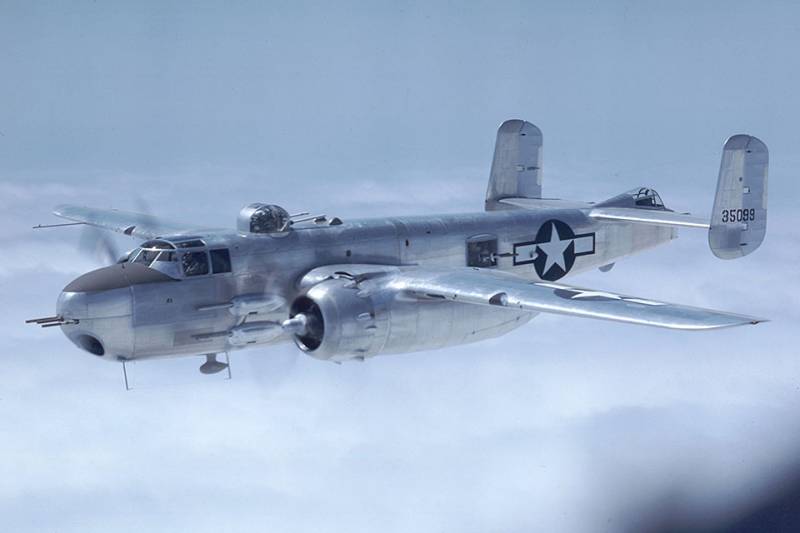
By the beginning of World War II, the United States did not have combat aircraft intended for direct aviation support of ground units and fight against armored targets on the battlefield. The most obvious way seemed to be the creation of a specialized attack aircraft armed with a cannon capable of penetrating enemy armor. tanks. However, as subsequent events showed, this path turned out to be a dead end.
Fighters with 37–40 mm guns
During World War II, mostly weapons American fighters had 12,7-mm machine guns, quite effective against enemy aircraft, but low-powered even against light armored vehicles. 20-mm guns were installed quite rarely and in terms of armor penetration they almost did not differ from heavy machine guns.
To increase the range of fire and lethal effect on the target, American designers experimented with aircraft guns of a larger caliber, and in the United States attempts were made to arm combat aircraft with large-caliber guns.
Thus, the P-39D / Q Airacobra fighters were armed with a 37-mm M4 cannon with 30 rounds of ammunition. The mass of the gun without ammunition was 97 kg. Rate of fire: 140–150 rds/min. The gun fired with 37x145R rounds. The ammunition could include shots with fragmentation and armor-piercing shells.
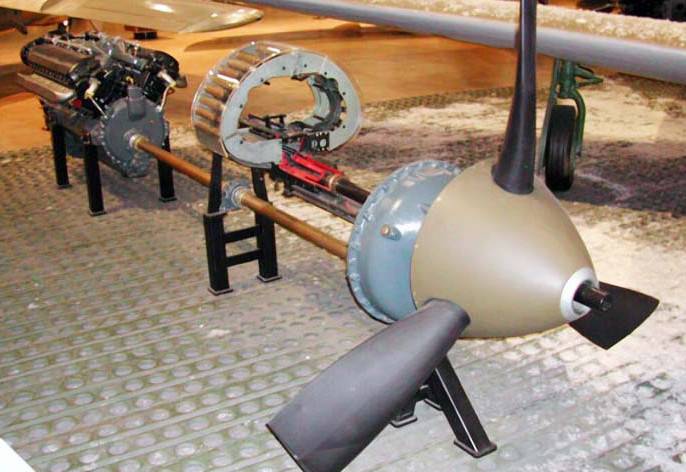
37 mm M4 motor cannon with 30-round ring magazine mounted on the P-39Q fighter
The fragmentation projectile weighed 608 g and was equipped with 48 g of plasticized RDX. An armor-piercing projectile weighing 753 g left the barrel with an initial speed of 556 m/s and could normally penetrate 32 mm armor of medium hardness at a distance of 400 m. A fragmentation projectile under the same conditions overcame 20 mm armor.
The P-63 Kingcobra fighters were equipped with a 37-mm M9 automatic gun, based on the M1A2 anti-aircraft gun. The rate of fire of the M10 gun was 150-160 rds / min, and the ammunition on board increased to 58 rounds. The mass of the gun without ammunition is 184 kg.
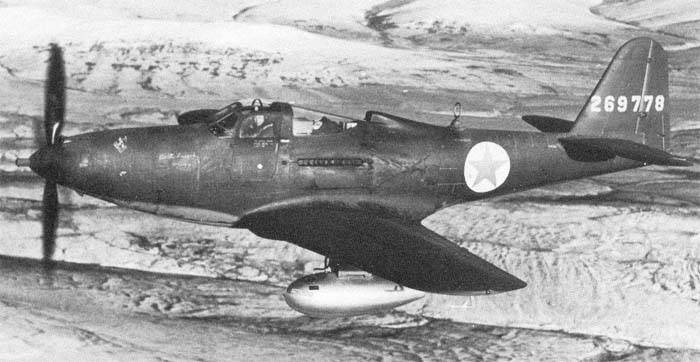
P-63 Kingcobra fighter with 37 mm gun
Unlike the 37 mm M4 aircraft gun, the M9 was powered by a metal band with disintegrating links. Shooting was carried out with a more powerful shot 37x223SR. According to reference data, a 753-gram armor-piercing projectile had an initial velocity of 930 m/s and could penetrate 450-mm armor at a distance of 60 m along the normal.
The 37-mm aircraft guns mounted on the Air Cobras and King Cobras showed a high destructive effect when firing at aircraft, but they could not guarantee penetration of the armor of heavy tanks. An indicative fact is that the USSR mainly supplied fragmentation 37-mm shells, which are more effective against air targets.
As an experiment, in 1942 the British armed one Mustang Mk. I with two 40 mm Vickers S guns.
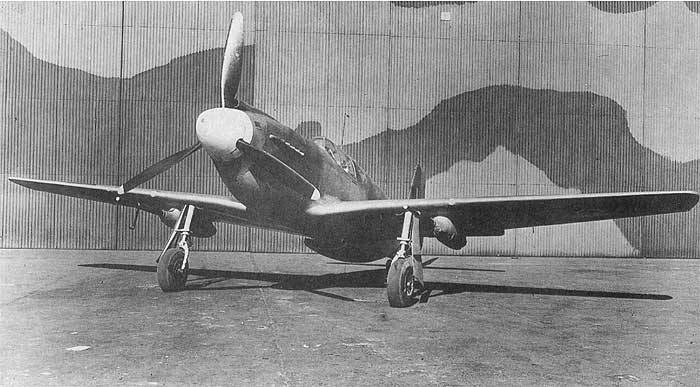
Fighter Mustang Mk. I with 40 mm guns
Cannon 40-mm installations greatly worsened the aerodynamics of the fighter, therefore, due to a sharp drop in flight data and due to the fact that the assault version of the Hurricane with 40-mm guns was already mass-produced, such a modification of the Mustang was not accepted into service.
Heavy attack aircraft based on the B-25 Mitchell bomber
In October 1939, studies began in the United States on the possibility of placing large-caliber artillery weapons on combat aircraft. The temptation was very great to create an aircraft capable of hitting tanks, ships, engineering structures or heavy bombers with a single shot from a large-caliber gun, without entering the zone of effective enemy return fire.
Artillerymen, far from aviation, did not see any particular problems in order to mount a cannon on a fairly large aircraft, while providing the possibility of aiming in vertical and horizontal planes, as well as to equip the guns with fragmentation projectiles with remote fuses designed to fire at a dense formation of enemy bombers.
The B-18 Bolo twin-engine bomber (created on the basis of the Douglas DC-2 transport and passenger aircraft) was used as a demonstrator. On the bomber, a fragment of the fuselage under the navigator's cockpit was dismantled, the bomb bay was sewn up, and the 75-mm gun and the crew, consisting of a gunner and loader, were placed in the fuselage.
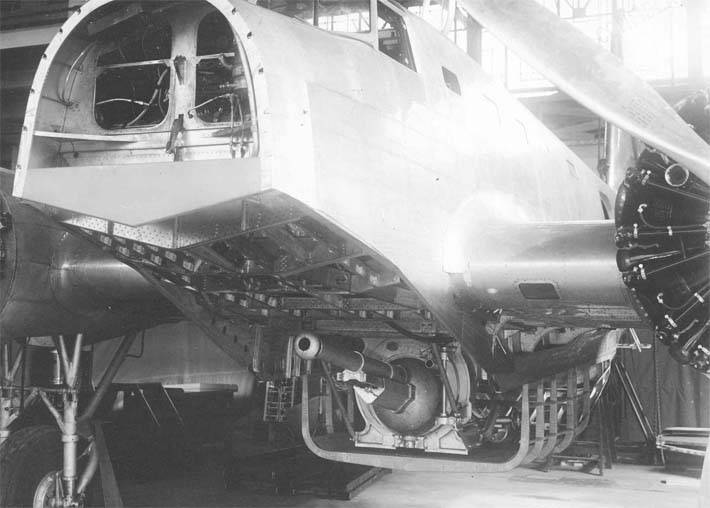
75 mm gun on V-18
Due to the fact that there were no ready-made aircraft guns of this caliber at that time, the old 75-mm French field gun Matériel de 75mm Mle 1897, which was in service with the US Army under the designation M1897, was used for installation on the aircraft.
In the mid-1930s, American specialists attempted to create an anti-aircraft gun based on a French gun. This installation was not launched into series, but the M2 tank gun was created on its basis. In addition to reducing the amount of rollback and a modified shutter, the tank gun had a pistol grip with a trigger. From April 1941, the 75 mm M2 gun was mounted on M3 Lee medium tanks.
However, the short barrel of the M2 did not allow it to have acceptable armor penetration, and in June 1941 the gun underwent modernization, which resulted in the appearance of a long-barreled 75-mm M3 gun, which was armed with many American tanks produced during World War II.
In June 1942, at a joint meeting of representatives of the Air Force and gunners, it was decided in the project of the heavy attack aircraft being developed to replace the 75-mm M3 gun with a lightweight version of the T9, which was under development. Nevertheless, the development of a large-caliber system based on the M3 was not stopped.
In anticipation of the completion of work on the T9 version, an order was placed for the manufacture of 750 aircraft 75-mm M3 guns on the T3E1 machine. In August 1942, the machine received the serial designation M6, and a slightly modified gun became known as the M4. One of the most interesting features of the aviation version of the 75 mm gun was the equipping of its automatic muzzle cover, which opens when fired.
The use of such an unusual device was caused by the fear that the bursting hot powder gases with incompletely burned powder particles could damage the skin of the aircraft. However, after practical firing, it turned out that the engineers' fears about the effect of hot powder gases on the airframe turned out to be in vain, and the muzzle was abandoned.
The weight of the artillery mount was 690 kg. 75x350R ammunition was used for firing. To destroy armored vehicles, a 75-mm M72 armor-piercing tracer weighing 6,8 kg was intended. Leaving the barrel with an initial speed of 618 m / s at a distance of 500 m at a meeting angle of 60 °, he could penetrate 70 mm armor, which was enough to confidently defeat German medium tanks and self-propelled guns based on them.
Also, the ammunition included high-explosive fragmentation shells M48 weighing 8,2 kg, containing 676 g of TNT. The high-explosive fragmentation projectile was able to break through 25 mm armor, which made it possible to use it against lightly armored vehicles. It took a well-trained loader 3 seconds to manually reload the gun.
To determine the real damaging effect of 75-mm armor-piercing and high-explosive fragmentation shells, at the end of 1942, the M4E4 Sherman medium tank and the submarine hull were fired from different directions from the M2 gun.
October 22, 1942 began testing an experienced artillery attack aircraft XB-25G. This aircraft was created by altering the serial bomber B-25C-1 Mitchell, produced by North American.
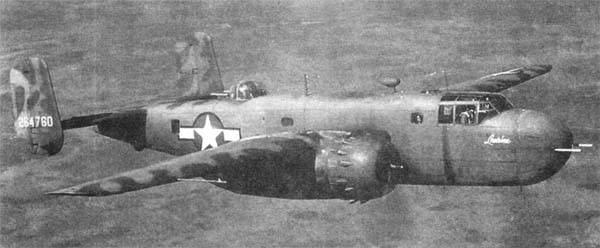
Experienced attack aircraft XB-25G, converted from a B-25С-1 bomber
The gun was placed in the nose of the aircraft, shifting it to the left relative to the longitudinal axis, shortening the fuselage from 16,09 m to 15,78 m. To the right of the gun was ammunition for 21 rounds. The 75 mm M4 gun was mounted on a rigid base under the co-pilot's seat. The barrel length was 2 mm, and the total length of the gun mount reached 780 mm, and it occupied part of the bomb bay. The crew of an artillery attack aircraft consisted of two pilots, a gunner, a radio operator and a navigator, who was also the loader.
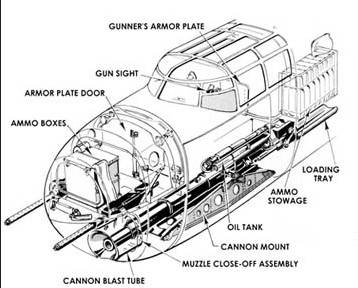
Scheme of placement of offensive weapons on the B-25G
In addition to the M4 cannon, two fixed 12,7-mm machine guns with 400 rounds of ammunition were installed in the forward fuselage, covered with a duralumin fairing.
Rigidly fixed cannon and front machine guns fired in the direction of the aircraft's flight. The pilot had at his disposal an N-3B optical sight and an A-1 bomb-artillery sight. In addition, for zeroing in, it was possible to use the tracks of course machine guns. When the target was under machine gun fire, a gun was fired.
After the successful completion of the tests, a contract was signed for the manufacture of 400 B-25G aircraft. The first attack aircraft (63 units) were converted from B-25S-1, B-25S-20 and B-25S-25 bombers. All newly built and converted B-25Gs had additional armor for the pilot's cockpit, loader's workplace and a box with 75-mm shells. The pilots' seats were protected by an armored back made of 11,4 mm steel sheet.
The B-25G attack aircraft had a normal takeoff weight of 15 kg. Two Wright R-870-2600 Cyclone engines with a capacity of 13 hp each. With. in horizontal flight, they provided speeds of up to 1 km / h. The cruising speed was 700 km/h. Practical range - 454 km. Ceiling - 399 m. In addition to the 2-mm cannon and two heavy machine guns firing forward, four 510-mm machine guns were part of the defensive armament. It was also possible to suspend a bomb load weighing 7 kg.
The US Air Force command considered the B-25G as a temporary measure. The main assault variant was the modification of the B-25H, equipped with a lightweight M5 gun. This 75-mm gun was considered as standard for use in the army and navy, as well as deliveries to the allied countries, primarily to the UK. The gun received the designation AN-M5, the aircraft machine for it - AN-M9 (the AN prefix denoted - for the army and navy, Army-Navy).
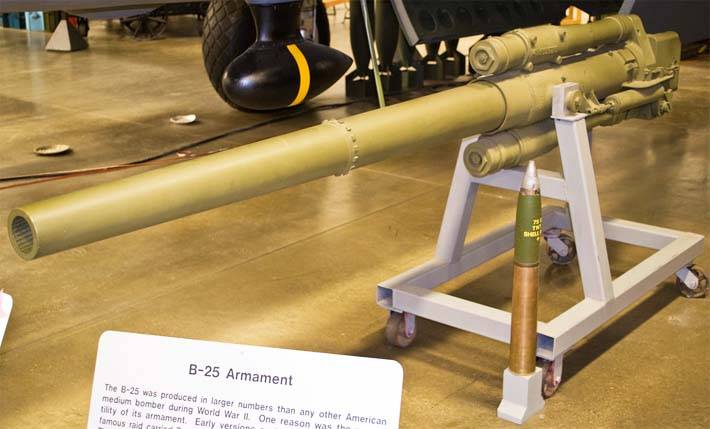
75 mm gun M5
The lightweight M5 gun weighed 184 kg, and the entire artillery mount weighed 346 kg. The barrel was shortened to 2 mm, and the length of the gun was 134 mm. To improve the accuracy of shooting, a new modification of the M2A956 gun was developed, in which the barrel cutting pitch was reduced from the original 5 mm to 1 mm per revolution. This led to an increase in the speed of rotation of the projectile and, accordingly, an improvement in accuracy. The ballistic characteristics of the gun remained practically unchanged.
The machine gun armament of the V-25N has become much more powerful. In the nose of the aircraft, above the cannon, not two, but four 12,7-mm machine guns were installed, each with 400 rounds of ammunition. On the starboard side, there were four more 12,7-mm machine guns in fairings. Behind the wings in the sides of the fuselage, on the turrets in the windows, one machine gun was placed. The windows were arranged so that the right one was closer to the wing, and the left one was closer to the tail. This allowed the gunners to simultaneously repel the attacks of enemy fighters without interfering with each other. There were two more 12,7 mm machine guns in the tail emplacement.
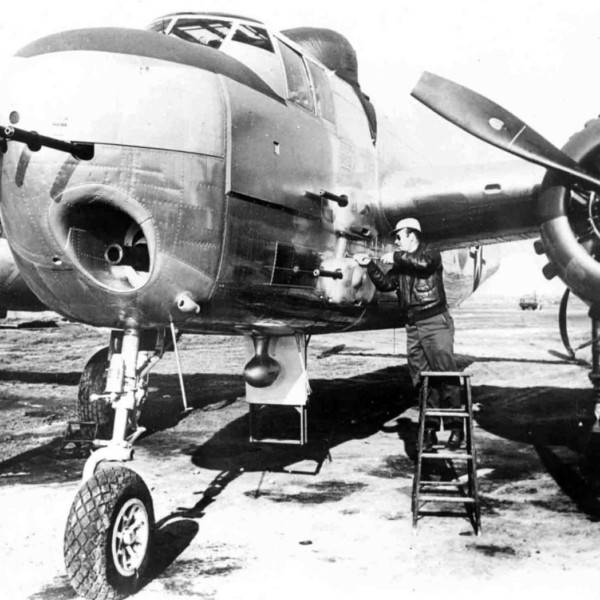
View of the B-25N front
The B-25N prototype, converted from the B-25S-10 bomber, took to the air on May 15, 1943. Although the B-25G attack aircraft was not as effective as expected, North American received an additional order for 1 B-000H aircraft armed with a 25-mm lightweight M75 gun.
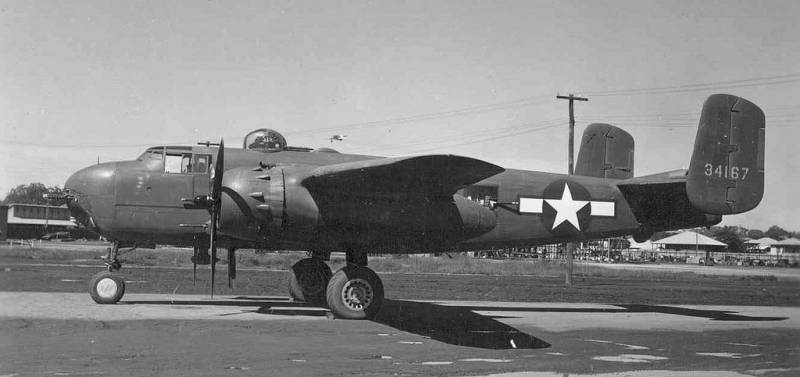
B-25H
The B-25N attack aircraft had a normal take-off weight of 15 kg and was equipped with the same Wright R-190-2600 Cyclone engines with a power of 13 hp each. With. each. The maximum speed was 1 km / h. Cruising - 700 km / h. Practical range - 441 km. Crew - 370 people. In addition to offensive weapons, the aircraft could carry bombs and missiles with a total weight of up to 2 kg.
Although the cannon B-25G / H were built quite massively, these heavy attack aircraft as a whole did not justify themselves.
The rate of fire and accuracy of fire of 75-mm guns when hitting point targets left much to be desired. Shooting from a cannon was effective at a speed of no more than 370 km / h. Upon reaching a higher speed, the stability of the aircraft deteriorated and, accordingly, the accuracy of shooting dropped sharply. In one combat run, at best, the 75-mm cannon could be fired three times.
And it was not even a matter of manually loading the gun, with the proper level of training, the loader ensured a rate of fire of 20-25 shots / min, but after each shot the sighting line went astray, the aircraft had to be leveled and re-aimed at the target.
Given the high efficiency of German anti-aircraft artillery, the B-25G / N aircraft were used very limitedly in Europe and mainly fought in the Pacific theater of operations. The Japanese had few tanks, and cannon attack aircraft were used to destroy bridges and command posts, suppress artillery batteries, and hunt for small ships.
So, in June 1944, not far from the coast of New Guinea, a pair of B-25Ns sank a Japanese destroyer with a displacement of 75 tons with the fire of 1-mm guns.
In general, attack aircraft with 75 mm cannons against point targets were no more effective than aircraft armed with only 12,7 mm machine guns. The experience of combat use has shown that in most cases, shelling a target with heavy machine guns and rockets, followed by dropping bombs, gave a better result than firing from a 75-mm gun. Often there were no worthy targets for the gun, and it was dead weight on board the aircraft.
For firing at ground targets, they tried to hang Bazooka anti-tank grenade launchers on the B-25N. However, due to the very short firing range, this weapon did not take root in aviation.
Experienced heavy attack aircraft XA-38 Grizzly
The successful experience of the combat use of the Soviet Il-2 attack aircraft served as the basis for ordering the US Air Force for a heavy armored attack aircraft with powerful offensive weapons.
In 1942, Beechcraft began building two prototypes. Initially, the heavy attack aircraft was supposed to be armed with a manually loaded 75-mm gun, and the loader was supposed to be part of the crew. On flight prototypes, a 75-mm M10 artillery mount with 20 rounds of ammunition was used. It was a 75 mm M5 cannon equipped with an automatic loader. The rate of fire was 55-60 rds / min.
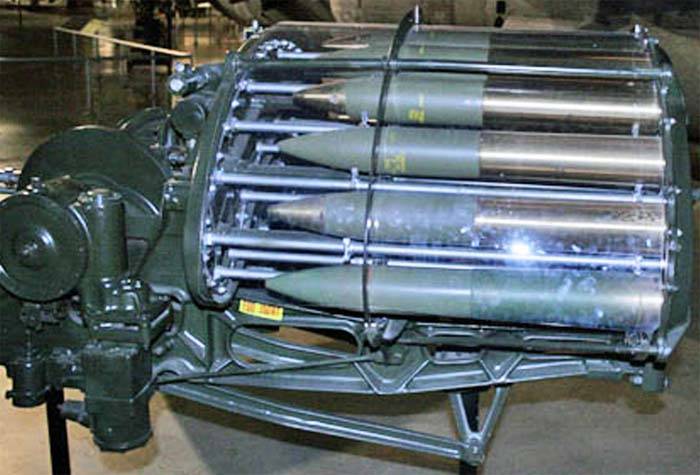
Shop 75-mm artillery installation M10
For forward firing, there was still a pair of 12,7 mm machine guns. The reflection of enemy fighter attacks from above and below was to be carried out with the help of two remote-controlled turrets, with a pair of large-caliber Brownings each.
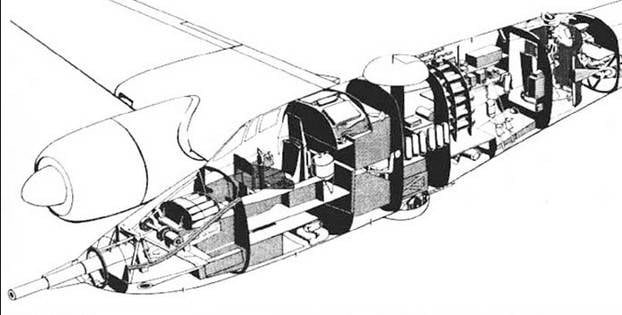
The internal layout of the attack aircraft XA-38 Grizzly
According to calculations, starting firing from a 75-mm gun from a distance of 700 m, before leaving the attack, it was possible to make 3-4 aimed shots at a small moving target. For preliminary sighting, it was supposed to use 12,7-mm machine guns equipped with cartridges with tracer bullets. Also, the attack aircraft was supposed to carry bombs and missiles.
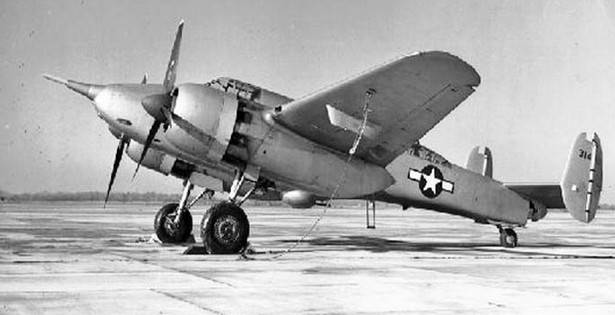
Experienced attack aircraft XA-38 Grizzly
The attack aircraft, designated XA-38 Grizzly, made its first flight on May 7, 1944. For a machine of this purpose, the Grizzly turned out to be quite heavy, its maximum take-off weight was 15 kg. However, thanks to two Wright R-996 engines (the same engines were used on the B-3350 Superfortress long-range bomber) with a capacity of 29 hp each. c. each, the maximum flight speed reached 2 km / h. The practical flight range without external tanks exceeded 300 km. Crew - 600 people.
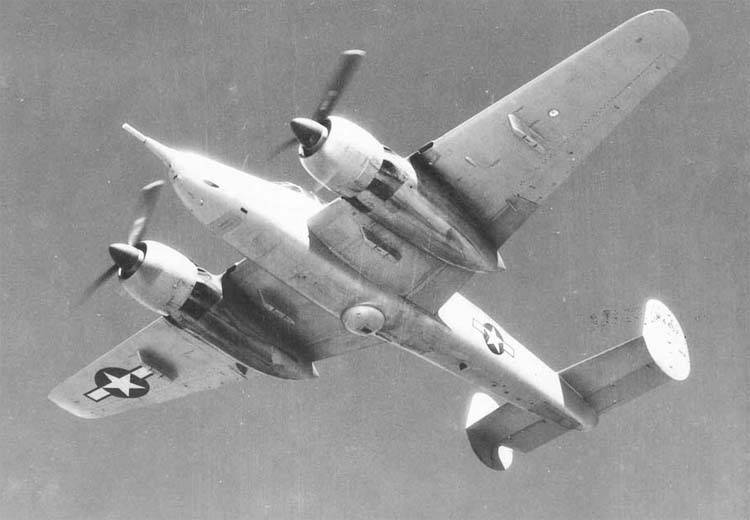
Due to the fact that the development of an attack aircraft and the construction of two prototypes took too much time, the US Air Force command considered that the Grizzly had lost its relevance. By the middle of 1944, it became clear that Germany and Japan could be defeated using the already available serial aircraft.
Experienced versions of the A-26 Invader attack-bomber with 37-mm and 75-mm guns
After the start of mass production of B-25G artillery attack aircraft, it was decided to arm the A-26В Invader twin-engine bomber with large-caliber guns, which was one of the best American combat aircraft of the Second World War and had good potential when used as an attack aircraft.
The serial Invader, launched into mass production at Douglas enterprises in September 1943, carried very powerful weapons, consisting of 6-8 12,7-mm machine guns in the bow, the rear hemisphere was covered by the upper and lower paired remotely controlled 12,7 -mm defensive installations. It was also possible to hang eight 12,7 mm machine guns in containers under the wings.
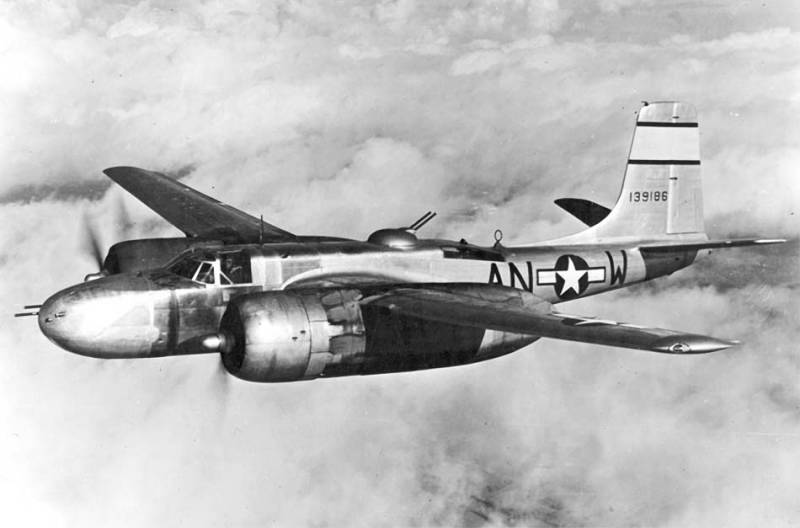
A-26V
An aircraft with a normal take-off weight of 12 kg and a maximum of 515 kg had a practical flight range of 15 km. Two Pratt Whitney R-875 engines with 2 horsepower. With. could accelerate the "Invader" in level flight to 250 km / h. Cruising speed - 2800 km / h. The maximum combat load in the form of rocket bombs and napalm tanks reached 2 kg.
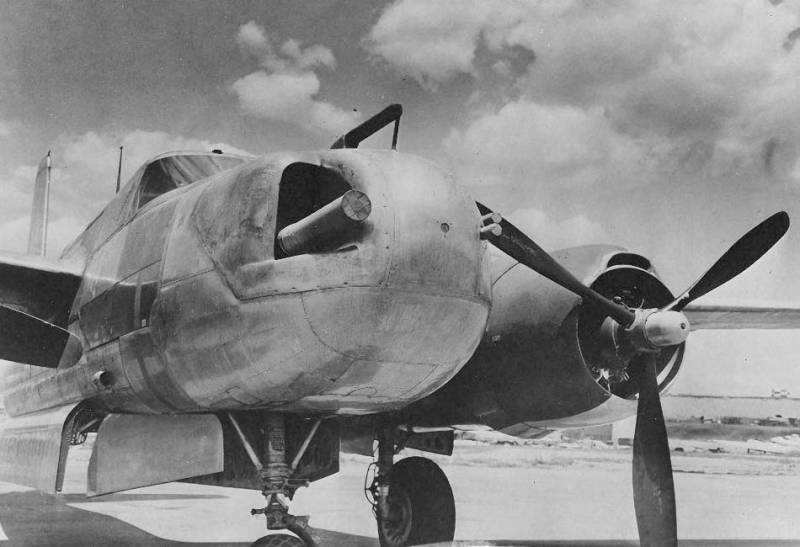
Experienced attack aircraft XB-26V with a 75-mm gun
An experimental modification of the KhV-26V attack aircraft, tested in the summer of 1943, was armed with a 75 mm cannon and two 12,7 mm machine guns. Variants with one 37 mm M9 cannon and two 12,7 mm machine guns and two 37 mm cannons were also tested.
The manually loaded 75 mm M5 gun had a low rate of fire and required an additional crew member on board or distracted from the onboard gunner's main duties. The use of the automated M10 gun made it possible to increase the rate of fire, but in this case, the massive artillery mount and ammunition occupied the entire internal volume of the bomb bay.
It was possible to aim from a 75-mm cannon at a point target at a flight speed of no more than 350 km / h, and after firing from a large-caliber gun, the speed dropped to 270 km / h.
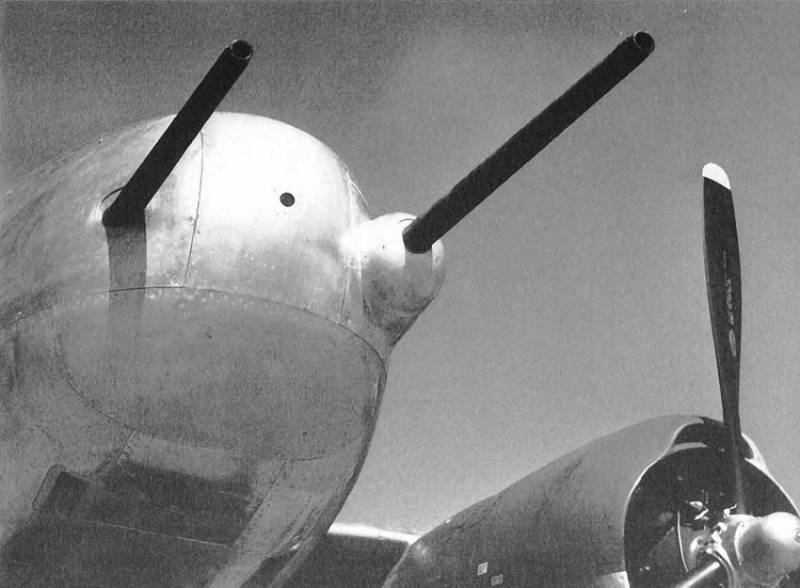
Experienced attack aircraft XB-26V with two 37-mm guns
In the case of arming the aircraft with 37 mm cannons, the bomb bay remained free, but this option had no advantages over a multi-barreled battery of 12,7 mm machine guns, which had better efficiency against uncovered manpower and unarmored vehicles. In addition, firing in long bursts from 37-mm cannons was impossible; after 2-3 shots, the aiming was lost.
According to the test results, arming the Invader with 37-mm and 75-mm guns was recognized as inappropriate.
To be continued ...
Information